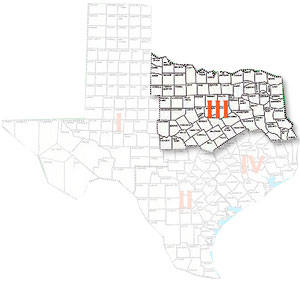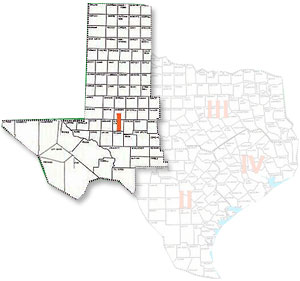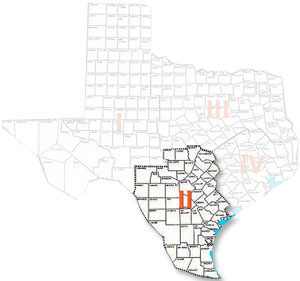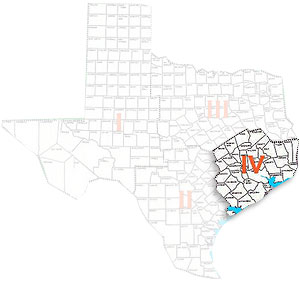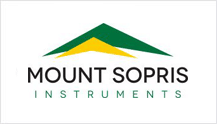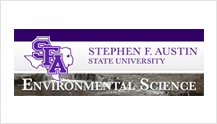AIPG District III – North Texas
District III Representative – Texas Section AIPG
Dr. James Henderson, P.G., C.P.G., Ph.D., Dallas, Texas
This page represents the activities of the American Institute of Professional Geologists in the South District III of Texas. This District is geologically complex and contains abundant oil and gas resources, lignite, uranium and other natural resources. Such resources have allowed Texas to develop a diversified range of high-technology driven petrochemical and related industries as well as a sound agricultural base, both with environmental awareness and effective regulation.
Oil & Gas Exploration & Development
District III covers the northeast quarter of Texas, and includes from its western border eastward, the Bend Arch, Fort Worth Basin and the East Texas Basin. Though the Bend Arch and Fort Worth Basin have been historically significant in Texas petroleum exploration and production, the East Texas Basin, with such fields as East Texas, Hawkins, Woodlawn and Van to mention a few, has in the past and continues to attract significant industry interest.
The East Texas Basin produces oil and gas from multiple Mesozoic-aged carbonates and sandstones. Currently, the most significant drilling activity targets the pinnacle reefs of the Jurassic-aged Cotton Valley formation, a 3D seismic dependent, expensive, dangerous, potentially lucrative play. Wells are permitted to 16,000 feet with an average completion depth of 15,000 feet. This is to test pinnacles ranging in size from 20 to 70 acres. Drilling and completion costs average $5 million per well. Bottom hole pressures range from 11,000 to 13,000 psi with 14,500 psi's reported, requiring 17-18 lb mud weights to control. Bottom-hole temperatures are on the order of 340-350°F.
The gas is sour and requires extensive processing and CO2 removal prior to sales. Most reefs are produced by a single well. Economics are based on conservatively estimated reserves of 20 bcf. With risked finding costs of 20 cents/MCFG equivalent or better, economic rewards offset the risks and costs of drilling. The play is attracting an aggressive group of mainly large and small independents.
Lignite/Coal Exploration & Development
This basin has over the past 20 years developed an important role in lignite exploration and mining. Centered in Northeast Texas, a number of companies are currently mining lignite. Production for 1996 was approximately 53 million tons. This makes Texas the 5th largest coal producer in the nation, The lignite is mined from the Wilcox Group (Paleocene-Eocene) and other Tertiary fluvial units.
In Texas, about 98% of all lignite mined is used for electric power generation. Approximately 27% of the electricity generated in Texas is from lignite. Texas imports 24% of its coal from several western states and is the largest consumer of coal in the nation, burning 93 to 94 million tons per year. According to the Bureau of Economic Geology of Texas, the demonstrated reserve base of surface mineable lignite is sufficient to fuel electric generation for at least 100 years. The mining industry in Texas is a mature and healthy industry, providing substantial economic support to the state's economy.
Texas Mineral Resources (here)
Environmental Issues:
Water Supplies
In a population of rapid growth, nearly full employment, and a free economy, Texas residents debate the age-old conflict between industrial development and the status quo, resource utilization and appropriate management, and associated environmental issues. But population growth and economic development, coupled with a climate in which surface-water resources are scarce, have imposed real and potential water-supply problems in many areas of Texas. In much of Texas, available surface storage capacity in existing reservoirs will barely be sufficient to meet water demands of continued industrialization and urban development, especially during critical droughts which are common occurrences over the long term.
Extensive development of the readily available ground water has progressed rapidly over the past 20 years but has resulted in several problems, some local in nature, while others are more widespread. Problems of water quality, both from natural and man-made causes (e.g. nitrates), are expected to affect the suitability for use of water from portions of Texas' aquifers in the future. Natural pollution, primarily sodium chloride, results from salt springs and salt flats within drainage areas of the basins. In some areas, this problem has been aggravated to some extent by oil and gas exploration and production activities. Mining has also been indicated as contributing to pollution. Balancing resources and local needs to maintain economic growth and development are the primary goals in Texas.
More than 50 percent of Texas in underlain by seven major aquifers and 16 minor aquifers. Because of industrial and urban development, long-term use of ground water is lowering water levels to the extent costs of production are increasing rapidly. Surface-water reservoirs are being developed in central Texas, and elsewhere, to offset the foreseeable problems of the future.
For additional information on the District's activities, see the North Texas Geological Society (here), the Dallas Geological Society (here), and others.
Index to Superfund Sites by County
If a county does not appear on this list, it is because there is no state or federal Superfund site in that county. This index includes all sites – those where cleanup is complete as well as those for which cleanup or assessment is in progress (here).
References:
Search Results for "Texas" (New)
Older References of Interest:
Spearing, D., 1991, Roadside Geology of Texas, Mountain Press Publishing Company, Missoula, MT, 418 p.
Fisher, W. L. , and W. E. Galloway, 1983, Potential for Additional Oil Recovery in Texas, Bureau of Economic Geology Geological Circular 83-2, pp.6-7.
Campbell, M. D., and K. T. Biddle, 1977, Chapter 1: Frontier Exploration-Uranium, in Geology Alternate Energy Resources in South-Central United States, Houston Geological Society, M. D. Campbell (ed), pp. 3-44. (PDF)
Dickinson, K. A., and J. S. Duval, 1977, Chapter 2: Trend Exploration-Uranium, in Geology Alternate Energy Resources in South-Central United States, Houston Geological Society, M. D. Campbell (ed), pp.45-66. (PDF)
Wielchowsky, C. C., et al., 1977, Chapter 6: Frontier Exploration-Lignite, in Geology Alternate Energy Resources in South-Central United States, Houston Geological Society, M. D. Campbell (ed), pp.125-159.
Bebout, D. G., 1977, Chapter 12: Trend Exploration-Geopressured Geothermal Energy, in Geology Alternate Energy Resources in South-Central United States, Houston Geological Society, M. D. Campbell (ed), pp. 251-273.
Kallus, M. F., 1977, Chapter 4: Environmental Considerations-Uranium, in Geology Alternate Energy Resources in South-Central United States, Houston Geological Society, M. D. Campbell (ed), pp. 83-109.
Hirsch, A. M., 1977, Chapter 9: Environmental Considerations-Lignite, in Geology Alternate Energy Resources in South-Central United States, Houston Geological Society, M. D. Campbell (ed), pp. 193-202.
Gustavson, T. C. and C. W. Kreitler, 1977, Chapter 14: Environmental Considerations-Geopressured Geothermal Energy, in Geology Alternate Energy Resources in South-Central United States, Houston Geological Society, M. D. Campbell (ed), pp. 297-336.
Evans, T. J., 1974, Bituminous Coal in Texas, Bureau of Economic Geology Handbook 4, 65 p.
Kaiser, W. R., et. al., 1980, Lignite Resources in Texas , Bureau of Economic Geology Report of Investigations No. 104, 52 p.
Jones, D. C., 1973, An Investigation of the Nitrate Problem in Runnels County, Texas, Texas Water Development Board, EPA-R2-73-267, June, pp.6-7.
Brown, L. F., et. al., 1976, Environmental Geologic Atlas of Texas Coastal Zone- Corpus Christi Area, Bureau of Economic Geology, 123 p.
Bebout, D. G., et al., 1976, Geothermal Resources, Frio Formation, Upper Texas Gulf Coast, Bureau of Economic Geology Geological Circular 76-3, 47 p.
Dorfman, M., and R. O. Kehle, 1974, Potential Geothermal Resources of Texas, Bureau of Economic Geology Geothermal Circular 74-4, 33 p.
Smith, G. E., et al., 1982, Regional Hydrodynamics and Hydrochemistry of the Uranium-Bearing Oakville Aquifer (Miocene) of South Texas, Bureau of Economic Geology Report of Investigations No. 124, 31 p.
Galloway, W. E., et al., 1982, Depositional Framework, Hydrostratigraphy, and Uranium Mineralization of the Oakville Sandstone (Miocene), Texas Coastal Plain, Bureau of Economic Geology Report of Investigations No. 113, 51 p.
Collins, E. W., et al., 1980, Quaternary Faulting in East Texas, Bureau of Economic Geology Geological Circular 80-1, 20 p.
Anon., 1984, Water for Texas: A Comprehensive Plan for the Future, November, Texas Dept. of Water Resources, GP-4-1, 72 p.
Ashworth, J. B., and J. Hopkins, 1995, Aquifers of Texas, Texas Water Development Board Report 345, November, 69 p.
In The News
Sponsors of the AIPG-TX GEODAYZ Training Program
2022
2018

